As pressure mounts for OEMs to reduce costs, Simufact explains why the design and development stages are crucial in making significant savings for complex assemblies
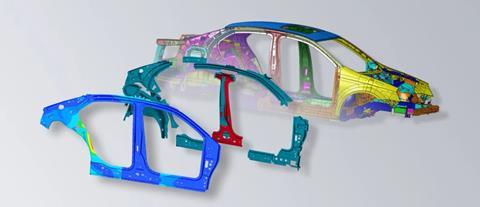
Today, OEMs are facing increasing pressure for cost reduction. Car manufacturers and component suppliers need to identify the right set screws to reduce their costs efficiently. Looking at the whole product development process with the phases of design, engineering, prototyping and production, there are several good opportunities to achieve this. The appropriate usage of simulation tools together with 3D quality data management will help provide high quality products while staying at a moderate cost level. This solution can be applied to any complex production that consists of manufacturing and assembly. A very good example is the body-in-white assembly.
Every vehicle body is produced with narrow specifications for dimensional tolerances. All parts of the outer skin must be flush. To guarantee this, the dimensional stability of the outer skin as well as the underlying structural parts is of crucial importance. The process of producing a general assembly consists of a series of manufacturing and assembly operations. Component parts are produced and then assembled to form functional pieces. The dimensions of each component part affect the dimensions of the assembly.
It is obvious that the layout and control of manufacturing and assembly operations and the component design have significant impact on the achieved product dimensions. In order to save costs, any corrective actions to ensure dimensional stability of the components must be considered as early as possible during the process of product development. A component design that takes already into account product manufacturability will reduce the number of loops during design and engineering dramatically. Virtual assembly operations will reduce costly physical prototyping to the (today still) necessary absolute minimum. The key to fulfil these demands is the usage of a software solution that combines a framework for 3D quality data management and visualisation to virtual manufacturing and assembly.
Real time management of data
Manufacturers need to use the heterogeneous measurement data drawn from automated and manual metrology systems to inform decisions throughout the production cycle, but that means being able to integrate and analyse dimensional data efficiently and accurately. They need a system that can deal with the growing quantity of dimensional data generated by 3D optical metrology systems, comprehensive tactile measurements – and – simulation tools.
The software package eMMA, developed by Hexagon Manufacturing Intelligence, is capable of handling any relevant source of data. It is used to manage, analyse, and visualise dimensional data across various stages of the product lifecycle within a single system. The software offers native 3D interactive functionality and integration with product data management (PDM), product lifecycle management (PLM) software, and other enterprise software systems. Software package eMMA is the state-of-the-art tool for global manufacturers to handle quality data in sectors ranging from automotive to shipping.
Virtual manufacturing and assembly
Most manufacturing operations for vehicle bodies are forming, welding or joining operations. These operations have to be validated and optimised for robust serial production. Traditional methods with ‘trial and error’ physical testing lead to high development costs and long lead times. The use of modern, practical and dedicated numerical simulation tools allows for fast, affordable, yet accurate virtual process simulation. This allows for numerous tryout and validation loops at an early part-and process-development stage, and at a fraction of the time and cost of physical testing.
A cost estimation and formability study can already be performed in an early design phase by using a real-time virtual manufacturing solution as provided by FTI technologies. Incremental manufacturing simulation solutions are used in a later stage to gather more precise information. They require more detailed information about the manufacturing process.
Simufact is a leading software vendor in the field of virtual manufacturing and assembly and part of Hexagon Manufacturing Intelligence. The provided software solutions are used in all kinds of industries to simulate any kind of forming, welding or joining operation. Powerful capabilities are offered to virtually look at operations that are relevant in vehicle body production, for example: sheet forming, deep drawing, clamping, resistance spot welding or mechanical joining operations.
Simulation is capable of considering all relevant process parameters, material properties and information from production and makes reliable predictions of product dimensions, distortions and product properties. This enables the shift to development and optimisation of manufacturing and assembly processes from the shop floor to the computer.
Assembly simulation with Simufact enables the engineer to virtually run any manufacturing or assembly process. The virtual manufacturing of a single sheet and its processing to a component part can be simulated and evaluated as well as joining together several components by spot welding to a readily assembled product. (See Figure 1 below).
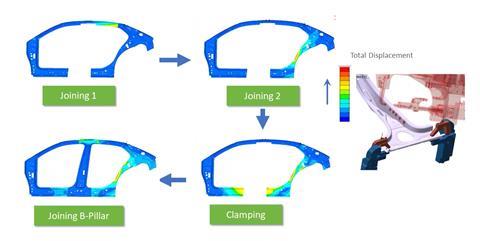
Combined software solution
The combination of real time production quality data management and virtual manufacturing or assembly provides a powerful solution to support cost optimised product development. Complex assemblies like vehicle bodies with their strict quality specifications, take the maximum benefit out of this. The framework provided by eMMA delivers data management and visual analysis along design, engineering, prototyping and production. It manages the automated flow of all relevant data.
The simulation of the manufacturing and assembly operations delivers information about the influence of the component design and of manufacturing parameters on the exact dimensions and properties of any component at each stage of the manufacturing and assembly process. Thus, comprehensive and continuous virtual manufacturing in parallel to the physical processes is enabled. Based on virtual measurements, relevant decisions in quality control are made in exactly the same way as physical measurements from inspection systems. The same analytics are used for measurement data in both engineering and production.
Virtual measurements and physical measurements can be brought together in a 3D interactive environment for in-depth analysis and comparison. This involvement of virtually measured data enables early steps in the design and engineering phase: Virtual manufacturing can be done before any physical part has been manufactured. This offers insight into the actual dimensions of the products as they are to be expected to the end of real manufacturing. A strong reduction of prototypes will lead to significant cost savings.
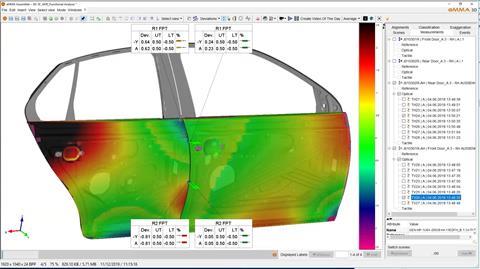
Manufacturing simulation can already be done during the design phase if some experiences regarding the manufacturing processes to be applied are available. This will help to design components which are really manufacturable. This leads to a viable design for the whole assembly with as few physical testing processes as necessary. Early flush and gap analysis can be performed with purely virtual data. The combined software solution can map the inspection plan to the 3D simulation results that include the actual simulated shape of the parts. The local deviation between nominal and actual dimensions at each specified position is predicted as seen in Figure 2 (above).
Components virtually produced by different variants of a simulated manufacturing process can be put into the assembly and can be compared – very similar to what is usually being done with a number of different parts that are already manufactured and physically available together with the appropriate results from physical measurement.
Physical measurements together with virtual measurements form a (big) data base for each manufacturing and assembly environment. Artificial intelligence algorithms will derive knowledge out of it to draw conclusions – for fast and accurate decisions in design, engineering, prototyping and production.
To download the full AMS January-March 2020 digital magazine click here.

































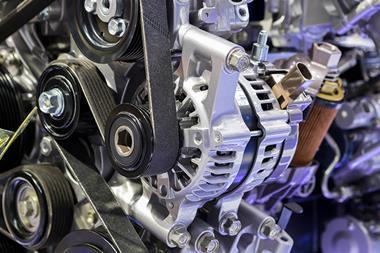
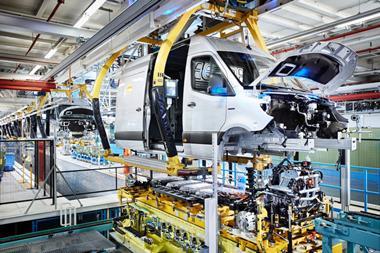







No comments yet